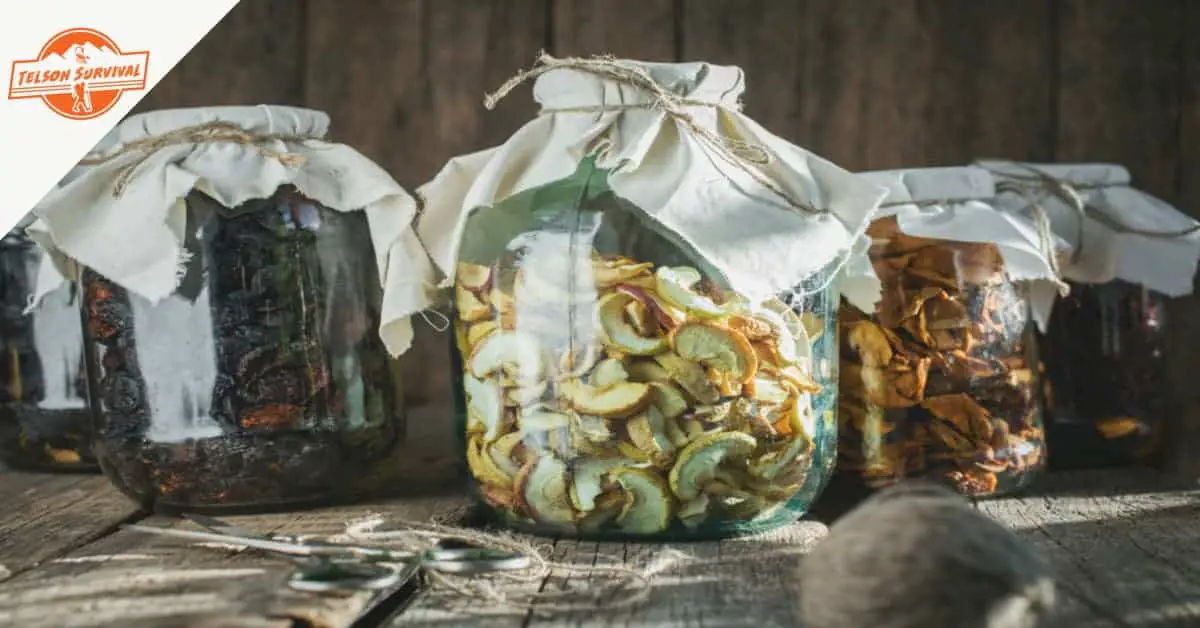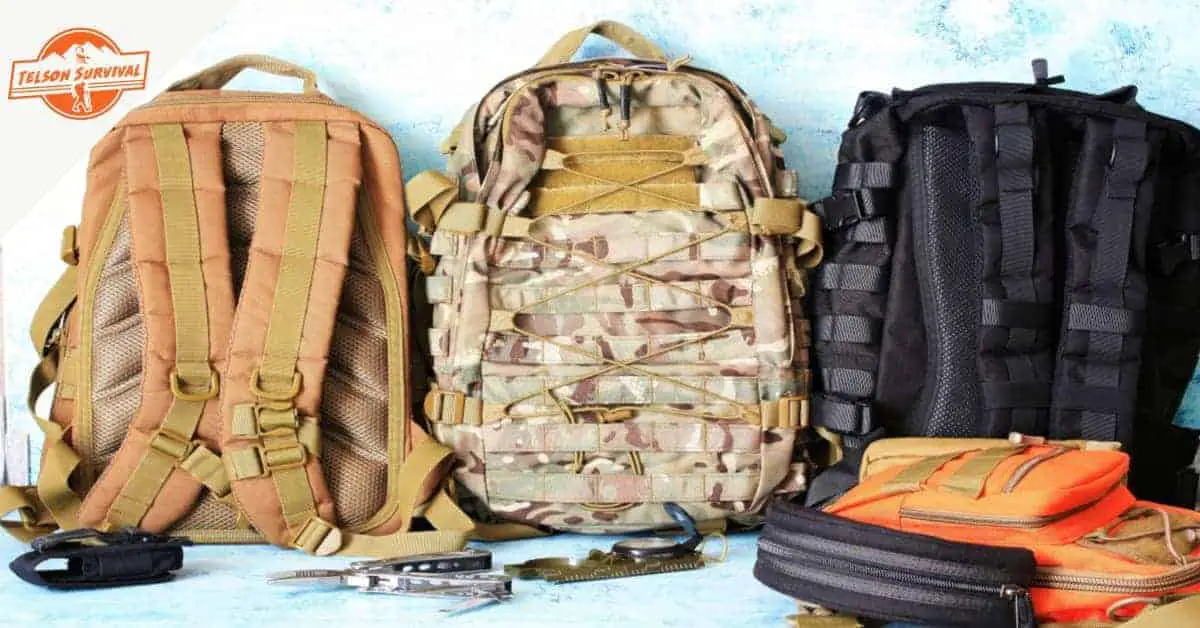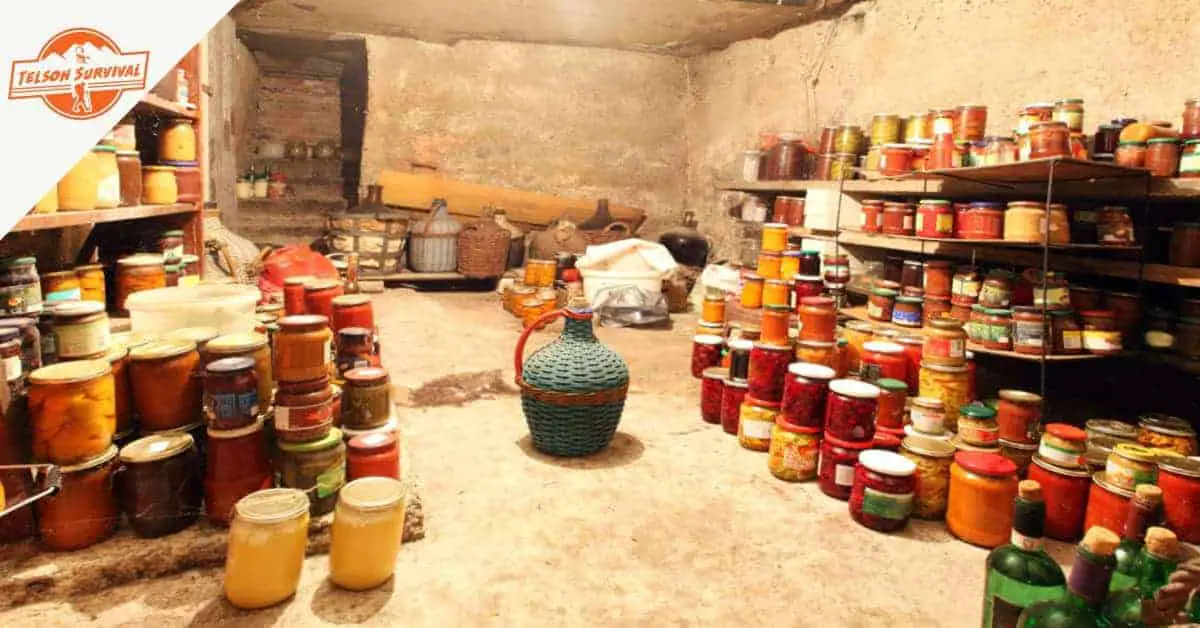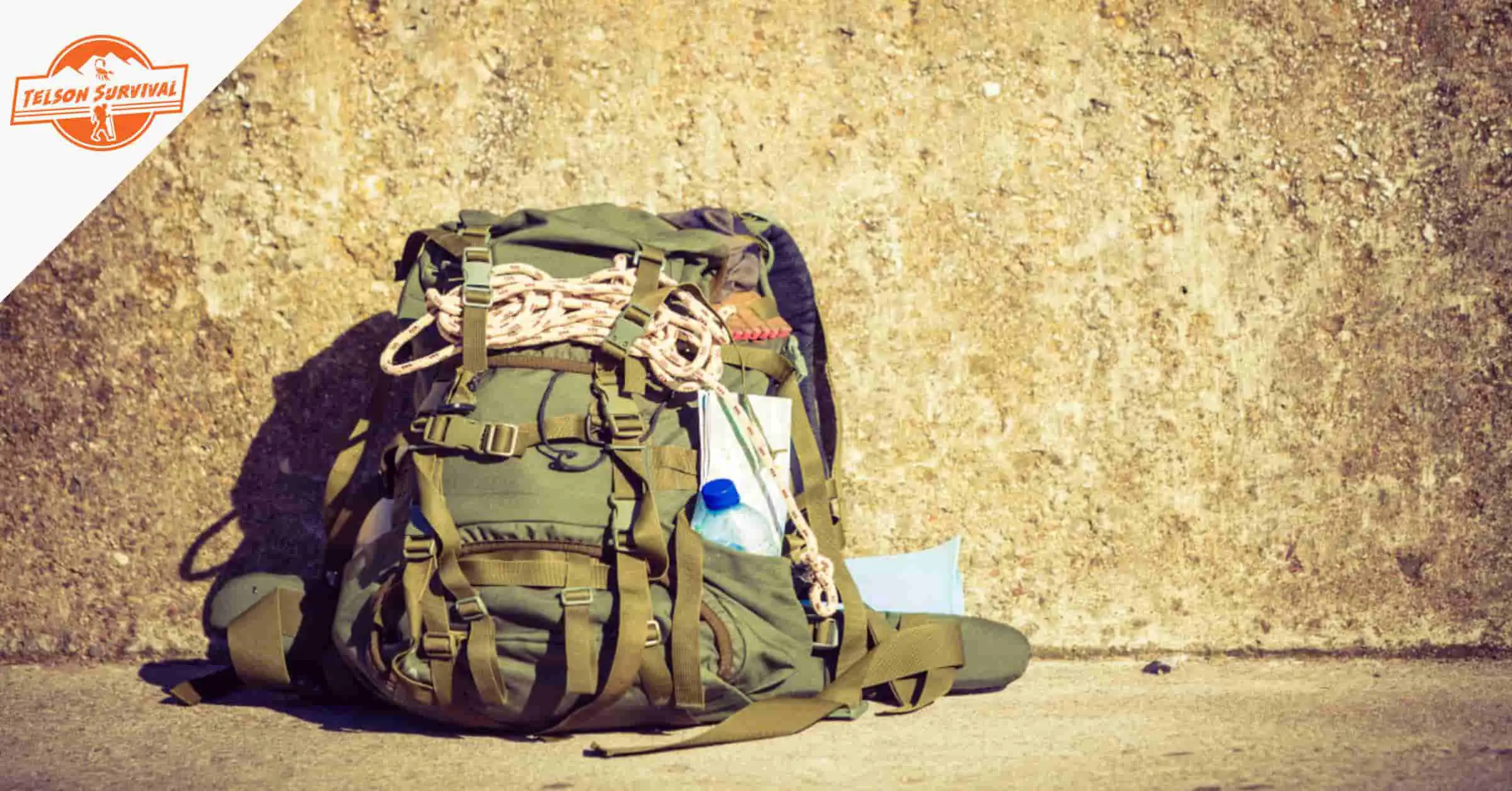Preserving your survival food by dehydrating it is only the first step in assuring your food security for the long term.
If you do not know how to store your survival food, you could potentially have all the hard work and effort of dehydrating it go to waste.
Storing your survival food properly is the key factor in how long it will keep. Improperly stored dehydrated food can easily go bad and potentially leave you in a pinch in an emergency.
In part 1, we thoroughly discussed the science behind why dehydrating is one of the best ways to preserve your survival food.
In part 2, we filled your head with some great ideas on what are the best survival foods to dehydrate how to use that food. Now we're going to dig deep into how to store dehydrated food for the long term.
How Long Does Dehydrated Food Last?
The answer to this question can be confusing. If you look around on the internet, official sources like university extension services and the National Center for Home Food Preservation will tell you that dehydrated food can be stored for up to a year.
Other sites and food preservation enthusiasts swear that you can store your dehydrated food for up to 25 years!
So, what's the deal? Why is there such a huge difference? Who should you believe?
The NCHFP and other university extension services make their recommendations based on years of science and study. They are extremely cautious in their recommendations. Their goal is to promote the safest practices in home food preservation.
They are also taking into account the nutritional value of dehydrated food, which tends to degrade over time. Different vitamins, such as thiamine and vitamin C, degrade significantly in storage and can be nearly non-existent after being stored for 12 months in less than ideal conditions.
That is why they give such a short shelf life to home dehydrated foods. Does that mean you should toss your dried fruit or meat after a year? Heck no!
Under the right storage conditions, you can successfully prolong the shelf life of your dehydrated food (including its vitamin and mineral content) for up to five years or more.
How To Tell If Your Dehydrated Food Has Gone Off
The thing you need to remember is to always check your food before you eat it. Even if you are planning on eating something that's only been stashed away for 4 months, give it a sniff and a thorough look over before putting it in your mouth.
Never take your chances on eating something that is even remotely questionable.
Here are some obvious signs to look for:
- Any visible mold or fungal growth.
- Color changes.
- Changes in the expected texture.
- It doesn’t smell right.
- It tastes off.
If any of these changes have occurred, be safe, and toss the food.
How to Store Dehydrated Food
Successfully storing your dried down food has everything to do with how long it lasts. You've probably heard of storing dehydrated food in mylar bags, or vacuum sealing dehydrated food for long term storage. But what works best?
Before we get into the different storage options, let’s talk a little bit about the different factors that influence the shelf life of your dehydrated foods.
- Moisture: This is the most obvious enemy of your dehydrated foods when it comes to long term storage. Food can easily absorb moisture from the air after dehydrating. You need to store your food in air-tight containers.
- Temperature: The warmer your food storage area is, the shorter the shelf life on the foods and the faster the vitamin and mineral content will degrade. Store your dehydrated food in a cool environment with an ambient temperature of 60 degrees (15 C) or less.
- Light: Vitamins, particularly riboflavin, ascorbic acid, and thiamin quickly degrade with exposure to light. You’ll also notice distinct color changes in dehydrated food exposed to light. Store your packaged food in a dark container or in a dark space.
So, let's explore the different options for storing your survival food
Storing Dehydrated Food in Mason Jars
Mason jars are a natural choice for storing dehydrated foods. You can see what is in the jar and you probably have piles of them laying around. And let's face it, they look good. There's nothing quite as satisfying to behold as a pantry full of colorful jars.
We recommend that you use mason jars for storing dehydrated foods that you will be using in the short term.
Why is that?
Mason jars are easy to open and reseal with either a vacuum sealer attachment or a simple oxygen absorber placed inside the jar. Opening and closing them is convenient and hassle-free.
It is easy to keep on hand quantities of foods that you will use relatively quickly. Smaller half-pint jars are great for herbs and spices. The large half-gallon and gallon jars are fantastic for cereals and grains. Pint and quart jars can be used for vegetables, fruit, meat, and special mixes you may have prepared.
Here are some tips for extending the shelf life of your dehydrated food stored in mason jars:
- Always reseal the jar after opening.
- Store in a dark location.
- Only keep on hand what you can use within 3 - 6 months.
- Sterilize and dry the jars before putting food in them.
Vacuum Sealing Dehydrated Food
Vacuum sealing dehydrated food into specialized vacuum bags is a great way to protect it from oxygen and moisture. It will also minimize the space that your food takes up in the pantry.
Vacuum sealing your food is a great way to preserve it for long term storage of six months or more. This is because it removes all the air from the package while protecting the food from any and all outside contaminants like mold and moisture.
If you want to see our recommendations for vacuum sealers, check out our guide on the 5 best survival food vacuum sealers.
Here are some tips to keep in mind:
Create packages that contain convenient portions.
For survival meals, you will want to portion meals according to the size of your family. Plan for about 150g of dehydrated food per person.
If you are packing away dried grains, beans, cereals, etc., consider creating 1 or 2 lb. packages. It should be an amount that you can open and use in a fairly short amount of time (1 - 3 months) after initially breaking the seal.
For dried fruits, vegetables, and meats - stick to the same rule.
Reseal the package every time.
If you are going to open up a package of powdered potatoes, for example, but you only use ½ the package, be sure to reseal the remaining contents of the bag. Even if you plan on using them next week, moisture could get into the contents and ruin them.
The same goes true for dried fruit and beef jerky.
An alternative would be to transfer the contents to a mason jar, which you can then reseal. This will save your vacuum bags (every time you reseal you lose a little bit of bag) for future use.
Protect the bag from sharp foods.
Some foods, when fully dehydrated, become rather sharp. This is mostly true for veggies and precooked, dehydrated grains.
To protect your vacuum bags, you can use specially designed bone guards or line them with paper towels or wax paper.
The danger in sharp foods lies in the fact that they can create pinholes in the vacuum bag.
These pinholes will let a slow seep of air into the bag and effectively ruin the seal. The danger is that you may not realize the seal of your bag was compromised until you go back to use the food.
Which brings us to our next point…
Periodically check your vacuum-sealed food.
It’s easy to think that once the bag is sealed you can just stash it away and forget about it for a while.
Make a habit of periodically checking on your vacuum-sealed dehydrated food to verify that the packages are all still sealed appropriately.
If you find a package that has mysteriously lost its seal, check the contents to make sure they have not gone off, and move that food to the front of your rotation.
Store vacuum-sealed dehydrated food away from light.
Most vacuum sealer bags are transparent. This means that you will need to store your food in a protective storage bin or closet where it will receive no light.
Storing Dehydrated Food in Mylar Bags
Mylar bags are the survivalists standard weapon when it comes to long term survival food storage.
Mylar is basically a polyester bag that has been infused with metal. These things are nearly indestructible. They are also impermeable to light, heat, gas, moisture, and most pests when properly sealed.
Storing your survival food for the long term in mylar bags does not require any fancy equipment. You do not need to vacuum seal the bag, and you can seal the bags with a simple household iron. All you need is the bag and some oxygen absorbers.
Choosing the Right Mylar Bag
There are literally an endless variety of sizes and thickness of mylar bags available out there.
Last update on 2024-07-13 / Affiliate Links / Images from Amazon Product Advertising API
You can purchase small bags that work for storing spices, medium sized bags that are ideal for portioning dried fruit and jerky, and larger bags that allow you to store an entire harvest of dehydrated potatoes.
You can even purchase bags in the 5 gallon size or larger that let you put up large quantities of grains, flours, or other dry goods.
Last update on 2024-07-13 / Affiliate Links / Images from Amazon Product Advertising API
It’s a good idea to have a variety of sizes on hand. Using the right size bag will let you economize the space in your pantry.
Make sure to pay attention to the thickness of the bag. A thicker bag will protect your food more efficiently from light contamination. It will also be more puncture resistant. We recommend that you use bags 5 mil or thicker for the optimal protection of your food.
Oxygen Absorbers
Oxygen absorbers are the key ingredient to successfully storing your dehydrated food in mylar bags. 300cc oxygen absorbers are a good “standard” to have ready to use when sealing up your food.
Last update on 2024-07-13 / Affiliate Links / Images from Amazon Product Advertising API
For a one gallon bag, use 2 packets. For any package smaller than that, use just one. If you are using a 5 gallon bag size, you will want to use at least seven 300cc absorbers.
These little packets will eliminate all of the available oxygen inside the sealed package. They do not remove other atmospheric gases, though, so don’t expect the bag to shrink up on itself.
Sealing the Bag
When the time comes to sealing your mylar bag, you will need to have a regular old clothes iron on hand and preheated. You could also use a hair straightener.
Make sure the inside of the bag is free and clear of any food debris. Put your oxygen absorber inside the bag, press the air out, and lay it flat. Quickly iron over the top edge of the bag. The seal should form within just a few seconds.
Other tips:
Here are some other things to keep in mind to help you successfully store your dehydrated food in mylar bags:
- Never forget that mylar bags are not rodent-proof! This means that you should store them inside a sturdy plastic container or another rodent-proof box.
Last update on 2024-07-13 / Affiliate Links / Images from Amazon Product Advertising API
Food grade 5-gallon buckets work best but you could also use larger storage tubs with tight-fitting lids.
- Clearly label every single bag with its contents and the date you packaged it. Mylar bags do not let you see the food inside. Labeling each bag is critical in avoiding unidentifiable mystery bags of food.
- You cannot store high-fat items for long term storage. Mylar bags undeniably help you maximize the shelf life of high-fat foods, especially when they are stored at room temperature. It won't, however, keep your fatty beef jerky or dried nuts from going rancid before other dehydrated foods.
Plan on consuming these foods within one year of storing them.
Other Tips and Tricks for Storing Your Dehydrated Food for the Long Term
It may seem that we’ve covered everything under the sun in this Ultimate Guide to Dehydrating food, but we feel like there are a few more tips and reminders that are worth throwing out there before we wrap things up.
The drier the better.
No matter how you choose to store your survival food for the long term, remember that the drier the food, the better. This is particularly true for meats and fruits which are typically "finished" with higher moisture content. If you want maximum shelf life, make sure your food has less than 5% residual moisture.
Condition your dried fruits and meats.
This simple process will help prolong the shelf life of your dehydrated fruits and meat.
How do you do it?
Put your dried food into a simple mason jar for at least one week without sealing it. Every day, check the jar for visible signs of moisture. If you see none, give the jar a shake and make sure the pieces of food move around and mix up inside the jar.
If you see moisture condensing on the inside of the jar, take everything out and dehydrate the food some more. Then start the conditioning process over again.
If no moisture shows up in the jar after seven days, you can confidently store your dehydrated fruit and meat for long term storage.
Consider this optional step as an insurance policy before potentially losing any of your food to mold, which is most likely to occur with fruit and meat due to its higher moisture content.
Create a rotation schedule.
Considering that all dehydrated foods gradually lose nutritional value over time, you should plan on rotating your foods through your survival food cache.
Some foods, like rice, can last well over a decade while your fruits and vegetables should be rotated through at least every five years or so.
Be strategic in using your food.
This goes hand in hand with creating a rotation schedule but has more to do with the logistics of rotating through your food. Create a system that allows you to minimize the opening and resealing of food packages. Consider packaging your food in portions that you can realistically use in 3 months. The idea is to not open the packages of food you have stashed for long term storage more than once.
Constantly inspect your survival food cache.
Between pinholes, failed seals, rodents, and other environmental hazards, you need to be sure to keep an eye on your survival food stockpile. There are several things that can cause your packaging to fail.
Every so often, you need to do a thorough inspection to make sure that everything is in order.
Pulling it All Together
Dehydrating your food is one of the best methods to preserve your survival food for the long term.
You can beef up your survival food pantry with natural wholesome food that will keep you nourished and healthy.
Now that you’ve read our guide, you have nothing holding you back. Take control of your food security today and get dehydrating!




![wisedry 300CC [100 Packets, 10 packs of 10 each] Food Grade Oxygen Absorbers for Long Term Food Storage, Keep Food Fresh O2 Absorbers Packets for Wheat Oats Flour and Freeze Dried Foods](https://m.media-amazon.com/images/I/41x6EmPKSHL.jpg)










